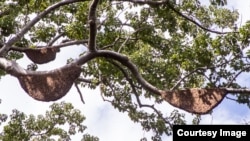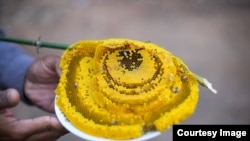Honeybees have a huge role in tropical ecosystems, but illegal logging and unsustainable honey harvesting are hurting their population. Honeybees have co-evolved with flowering plants and their overall health is an indicator of an ecosystem’s wellbeing.
Damian Magista, a specialist on honeybees and the founder of Bee Local in Portland, Oregon, recently returned from a research trip to Cambodia. Bee Local sells gourmet honey products. He told VOA Khmer he is concerned about a decline in the honeybee population.
Bees are “losing ground,” as ecological diversity slips and as traditional honey hunting practices, which can wipe out entire colonies, continues, he said by phone from Portland.
Magista spent about two weeks in Siem Reap and Banteay Meanchey provinces, visiting rural areas, and trying to learn more about Cambodian honeybees. Cambodia has two species, Apis dorsata and Apis florea, which are found mostly in Southeast Asia. The dorsata species, or giant honey bee, can produce a honeycomb up to nine feet long.
“We don’t see them here in the US, obviously,” Magista said. “You don’t find them in a lot of places. If we lose them, we’ll be losing out on a lot.”
The bees themselves are also beneficial, Magista said. The combs and honey are rich sources of food, and their wax is used in pagodas and places without electricity.
But a reduction in bees means a dwindling of a culture of beekeeping and bee products, he said. “Because the bees are dying out, that culture is slowly dying, as well,” he said.
Despite the decline, there is still potentially an international market for Cambodian honey, but it will require five- to 10-year programs, Magista said. “Have a group of folks teach them bee-keeping techniques and provide the support and infrastructure,” he said.
Cambodian honey could be sold for as much as $10 per kilogram, more than similar honey from Thailand or Vietnam, according to a USAID assessment.
In recent years, NGOs have supported some bee-keeping programs in Cambodia, such as the Angkor Center for the Conservation of Biodiversity in Siem Reap, and private-sector promotion projects in Pursat province, and the Cambodia Agribusiness Development Facility in Siem Reap and Banteay Meanchey provinces but those projects have stopped, according to the USAID assessment. In 2013, the Cambodian Center for Study and Development in Agriculture (CEDAC) exported its first 500 liters of honey to Japan.









